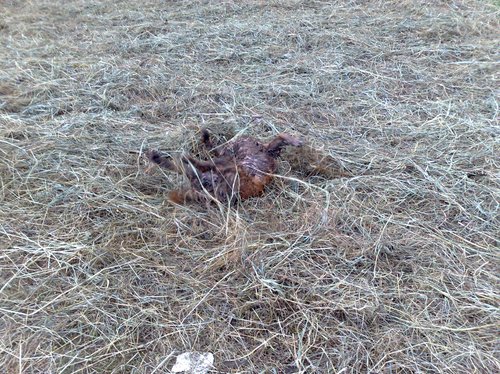
What’s this?
I’ve recently developed an interest in….metal detectors.
That’s right. Metal detectors that enable the search for metallic objects hidden some inches below the surface. Contrary to other places, the geographical middle of Europe seems to be blessed with archaelogical treasures.

Which leads me to the actual dilemma:
1. I actually don’t have any time to waste on another hobby.
2. There are so many other interesting hobbies I have.
3. I’ve always thought it may be better to limit myself to a few leisure activities (due to 1. & 2.) and focus on them only.
4. Most of my friends are academics or intellectuals who aren’t as geeky as I am and/or won’t have an interest in …strange….hobbies such as using a metal detector to search the nearby forest for Roman coins.
So I did a quick test and asked the freakiest freak-friend of mine who usually rumbles around in military clothes all day long and looks like a potential metal detector freak (he actually looks a lot like Al Yankovic in UHF) if he would be interested in joining me on such a hobby.
“Naa…”, he said, “…not really”.
See? This is the same reaction I received from most of my friends in 1994 when I started being interested in amateur radio. Or fishing. Or guitar playing. Or shooting. Or blogging. Or while repairing my old ’89 VW Golf. Or repairing electronics with a jua kali approach. Or my recently aquired toy helicopter. Or other handicrafts….
I’ve always been interested in geeky stuff – which isn’t that bad – but I’ve so often been alone on this. And then I’ve chosen those activities although there are other things I would really like to spend more time on. Like improving my guitar playing. Or learning more foreign languages. Reading the pile of books that’s next to my table – not fiction but books related to water & sanitation or political issues.
Well I am not complaining – for I am still free at this (advanced) age to do whatever I want to (uhuru!) and actually created this space in order to enjoy this variety. It’s only that I am wondering why I’ve always chosen such rather geeky hobbies instead of playing soccer with my mates or clubbing with the fiancée*.
What a luxurious dilemma this is! Get a life…
I know. I’m just sayin, u know…?
Oh, and btw, would you join me on a walk to the forest? Hey this is really cool, we can find great stuff!
*fiancée isn’t into clubbing and also says that metal detectors are for Spanish grandmothers who are combing the beaches, improving their pension.
[Disclaimer: I am yet to decide whether my I can afford to cough up USD 200 on such a metal detector if in the end I’ll only use it about 20x and then sell it on eBay…]
Just when I thought that nothing could stop us from a well-deserved vacation, visiting some dear friends in London – a journey we had anticipated for a long time – parts of my body revolted and sent me to hospital on Sato evening.
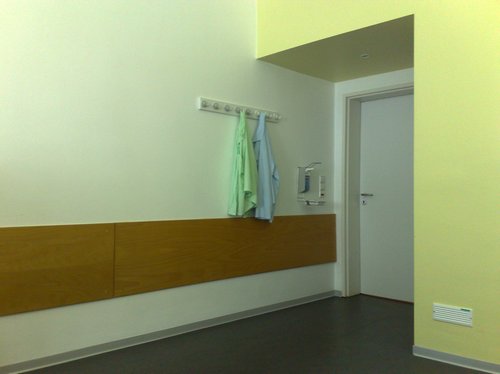
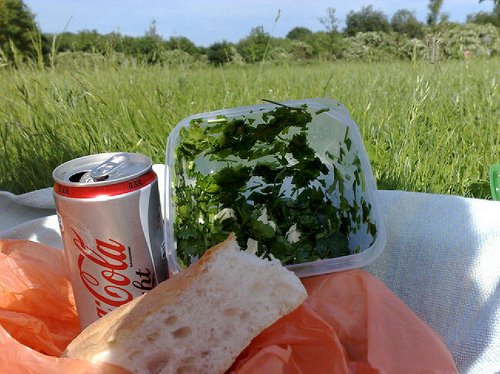
Coke light for her.
A salad made out of parsley, lovage, coriander and fresh white cheese for me.
Bread.
A huge Kikoi blanket from the shores of Lake Naivasha.
Sunshine.
I’ve started sharing links to videos and other interesting stuff on Facebook, Twitter and/or Delicious.com and often only use my blog for my own content (partly because I actually dislike reblogging someone else’s content), BUT! Daktari Hans Rosling of gapminder.org is a smart man with an important message:
I sometimes wish proper sanitation would have the same media attention.
Ein Artikel online über Demenz brachte mich auf Umwegen zu Tilman Jens, der ein sehr streitbares Buch über …. den Umgang mit seinem Vater, Walter Jens , geschrieben hat.
Überhaupt, dass ein 54jähriger Mann immer wieder als “Sohn von…” eingeleitet wird, wäre dann schon Grund genug, sich noch zu Lebzeiten zu differenzieren. Aber so?
Das Thema Alzheimer haben wir in der eigenen Familie von Anfang bis Ende durchlebt und nachdem der Spuk jetzt endlich vorbei ist, frage ich mich immer wieder: was bleibt?
Was bleibt – außer der Erinnerung, der Liebe, den Verbindungen – vom Intellekt, vom Schaffen zurück?
Menschen sind wie Bäume. Je älter sie werden, desto mehr Jahresringe bekommen sie und können besser verwertet werden. Spenden sie zu Lebzeiten Schatten und Schutz, können aus ihren Stämmen später lange und breite Bretter gesägt werden. Je mehr ein Baum erLebt, desto ergiebiger lässt sich davon profitieren.
Leider stimmt der Vegleich an dieser Stelle nicht mehr, denn Krankheiten wie Alzheimer oder Parkinson befallen Menschen wie ein Pilz, der die Substanz verändert und genau dort ansetzt, wo es am meisten schmerzt. Aus brauchbar wird unbrauchbar.
Eine ähnliche Frage stelle ich mir immer wieder bei Online Publikationen, die oft weniger breit und nachhaltig irgendwo im weiten Datennetz erscheinen und ob der Fülle an Informationen im Datennirwana untergehen.
Dieser Blogpost könnte auch ganz anders betitelt werden und ich könnte vielleicht von Anfang an hervorheben, dass ich mich viel lieber mit der Bedeutung von Onlineveröffentlichungen vs. Büchern beschäftigen würde.
Allein, ich vermag es in seiner Gänze nicht zu erfassen, gar zu überblicken, daher beschränke ich mich auf simple Fragen und stelle im Folgenden drei Bücher vor, die jetzt dank Amazon den Weg auf meinen Schreibtisch gefunden haben und sich elegant an der sonstigen Pflichtlektüre vorbeimogeln.
Die Pflichtlektüre besteht zur Zeit übrigens aus wissenschaftlichen Publikationen zum Thema Abwasserbehandlung in Entwicklungsländern, was zwar technisch überaus interessant ist, aber eben nicht faszinieren vermag – ganz im Gegensatz zu Gegenwartsliteratur über den afrikanischen Kontinent.
Eines aber noch vorweg: wenn wir in Zeiten einer WebCiety den Wechsel hin zu einer sich-ins-Netz-verlagernden-Gesellschaft bemerken, in der die Kommunikation miteinander an erster Stelle steht, stelle ich mir zwangläufig immer wieder die Frage: welchen Stellenwert haben Bücher (gedruckt, auf Papier) im 21. Jahrhundert?
Und: wer soll das alles lesen (?)…. in einer Zeit, in der die Aufmerksamkeitsspanne von Jugendlichen durch MTV und YouTube gerade einmal gefühlte 10 Minuten beträgt und wenn Informationen nicht mehr in kleinen Häppchen oder gar in Linkform präsentiert werden?
Wenn wir weiterhin davon ausgehen, dass sich moderne e-Book Reader (wie Amazons Kindle und kostengünstige Einsteigercomputer wie Netbooks als alternative e-Book reader) durchsetzen werden (oder gar Handyromane, wie in Japan schon sehr populär), wie werden diese Inhalte (und nur darum geht es eigentlich) mit dem neuen Konsumverhalten vernetzt? Werden unsere Kinder das Buch als solches wahrnehmen und konsumieren, oder eher als Teil des Wissens in einer virtuellen Bibliothek abspeichern? Und wie werden sie damit umgehen?
Alles Fragen, die mich immer wieder beschäftigen und die micht jetzt trotzdem nicht vom Kauf der folgenden Exemplare abgehalten haben:
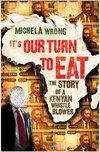
Michaela Wrong: “It’s our turn to eat – the story of a Kenyan whistle blower”
Über John Githongo und seinen Kampf gegen die kenianische Korruption. Aufgeschrieben von Michaela Wrong, die ihn seinerzeit in seinem selbstgewählten Exil in England aufnahm. Michaela Wrongs Buch über Mobutu wurde schon gierig verschlungen und liest sich gut, ähnliches erwarte ich daher auch von diesem Werk, das die (größtenteils schon bekannten) Verstrickungen kenianischer Politiker in Korruptionsskandale beschreibt .
Dieses Buch wird in Kenia zur Zeit wohl nur unterm Ladentisch verkauft und dürfte sich zu einem Beststeller entwickeln, denn – anders als der Verfall Kongos – handelt es sich bei Kenia um eines der reichsten Länder Afrikas. Freilich hat Kenia nicht die Bodenschätze, wie sie Botswana oder der Kongo (DRC) aufweisen können. Seinen Reichtum zieht es vielmehr aus der geopolitisch günstigen Lage am Indischen Ozean (Hafen, Tourismus), den vielen Exilkenianern im Ausland (die für einen informellen Geldfluss sorgen) und vielleicht auch noch aus der Agrarwirtschaft (Kaffee, Tee, Blumen). Und während viele Ministerien immer noch vom Geldsegen der EU abhängen, die gelegentlich ein paar Pickups als Projektautos finanzieren, verfügen viele kenianische Politiker über ein sehr gutes Einkommen, das im sehr krassen Verhältnis zu ihren eigenen Leistungen, aber vor allem dem Durchschnittseinkommen im Lande steht.
Korruption als solche mag für viele als Ausgleichssystem für die vielen Ungerechtigkeiten in der Volkswirtschaft verstanden werden. Tatsächlich jedoch ist sie wie ein Pilz, der ein gesundes System zerstört und unbrauchbar werden lässt.
Die wirkliche Kernaussage dieses Buches scheint aber zu sein, dass das korrupte System vom scheinbar eigenen Mann aufgedeckt worden ist, der als Vertreter einer neuen Generation mit anderen Werten und Idealen aufgewachsen ist. Was wir hier sehen, ist der ungerechte Kampf zwischen den alten Männern eines über die Jahre gewachsenen profitablen Systems und einzelnen Vertretern wie John Githongo, die über einen viel moderneren Erfahrungshorizont verfügen.
Wäre ich ein bißchen Deutscher und älter – vielleicht so wie Tilman Jens – würde ich es vielleicht mit den Identifikationsproblemenen der 1968/1978er Generation im Nachkriegsdeutschland vergleichen. Interessant dabei: die wirklichen Auswirkungen erkennen wir oft erst an der folgenden Generation.
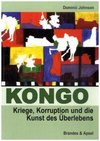
Dominic Johnson “Kongo: Kriege, Korruption und die Kunst des Überlebens”
Dominic Johnson ist mir als Afrika Korrespondent der taz bekannt, dessen Artikel seinerzeit mit einer der Gründe für mein taz-Abo waren.
Ich war noch nie im Kongo, jedoch steht die Region auf meiner Reiseliste ganz weit oben. Aufmerksame Leser meines Blogs wissen sicherlich, dass ich hier schon den einen oder anderen Artikel mit Inhalten zum Kongo (als Region, nicht nur DRC) veröffentlich habe. Kurzum: für mich ein überaus vielversprechendes Buch, in dem ich vielleicht auch meine Vermutung wiederfinden werde, dass sich die “Demokratische Republik Kongo” in den nächsten Jahren in Einzelstaaten aufteilen wird. Der Kongo ist die für mich zur Zeit spannendste Region Afrikas.
“Die Kunst des Überlebens” – ja. Trefflicher kann man es wohl nicht beschreiben.
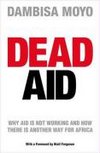
Dambisa Moyo: “Dead Aid – Destroying the biggest global myth of our time”
Ein Buch im Stil von Prof George Ayitteys “Africa Unchained – The Blueprint for Africa’s Future”, das die “Ablasszahlungen” des Westens an Afrika beschreibt und einen neuen Weg aufzeigen möchte, der wirkliche Entwicklung in Afrika ermöglichen soll.
Da ich auch in dieser aufgeklärten Zeit immer wieder auf Zeitgenossen stoße, die ein komplett falsches Bild vom afrikanischen Kontinent und dem riesigen Potential haben, ist es umso wichtiger, Vertreter neuer Theorien zu entdecken, die – wissenschaftlich fundiert – eine eigene Lösung aus der Misere beschreiben und idealerweise auch noch über die nötige berufliche Erfahrung verfügen, die ihre Glaubwürdigkeit untermauert.
In Dead Aid, Dambisa Moyo describes the state of postwar development policy in Africa today and unflinchingly confronts one of the greatest myths of our time: that billions of dollars in aid sent from wealthy countries to developing African nations has helped to reduce poverty and increase growth. (Quelle)
Dambisa wurde letztens auch von der BBC im HardTalk interviewt und ich habe sie vorhin via Twitter auf das Africa Gathering Ende April in London hingewiesen. Mal schauen was draus wird…Sie kann nicht, ist auf Lesereise in den USA.
The silver lining der hier vorgestellten Werke ist für mich ganz klar die Erkenntnis, dass es Veränderungen in Afrika nur durch eine neue Generation geben kann, die – aufgewachsen mit traditionellen Verhaltensmustern und typischen US-amerikanischen SitComs wie dem Fresh Prince of BelAir – ihren eigenen Weg finden muss.
UPDATE: Fünf Wochen nach VÖ dieses Beitrags ist in der FAZ ein Interview zu Dambisa Moyos Buch erschienen. Und jetzt hat sie sogar wohl noch im Vortrag bei der Weltbank überzeugt. Wer sich auch nur ein bißchen mit Afrika beschäftigt, sollte dieses Buch unbedingt lesen – kann es wärmstens empfehlen. Weniger um einen möglichen Lösungsweg aufgezeigt zu bekommen, als vielmehr die moderne Einstellung des neuen Afrikas zu verstehen.
Two and a half days aren’t enough to explore the full potential of a city. That’s why I can only present a few snapshots this time. Besides, I am too tired for a decent post these days.
Have been working on another professional blog for a paid project (no URL, pole) the last couple of weeks and whenever I open my own blog, I think about a relaunch. After all, I am still using the same template since 2006!
I urgently need to get some sleep asap and refocus my agenda on other, much more important matters (like my thesis, for instance).
‘Nways, back to Vienna and some visuals:
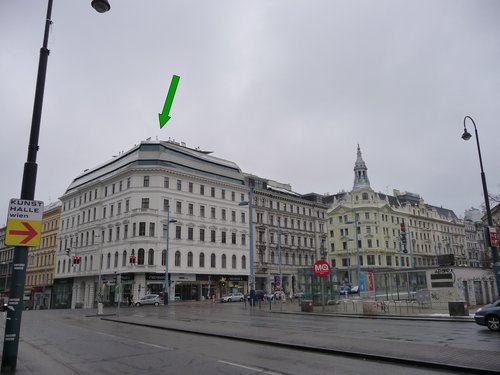
What a roof!
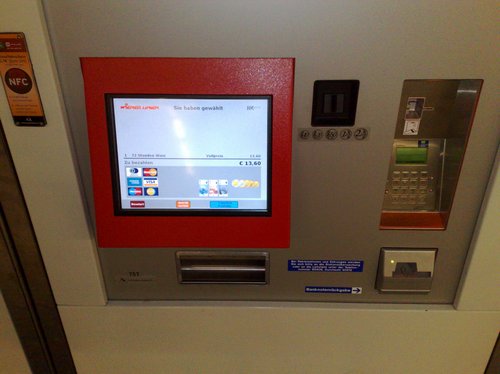
THE best ticket machine I’ve seen in Europe so far. Took us less than 10 seconds to buy a ticket for the metro. See my ramblings on RMV/Frankfurt am Main to understand why this is so important to me.
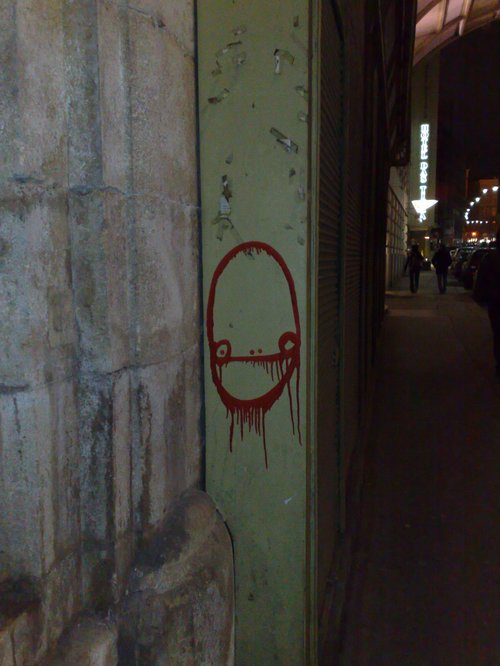
Lovely street-art next to Hotel Orient.
No, don’t ask. Garen showed us that place…
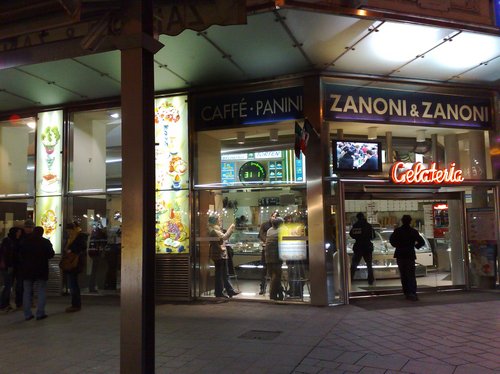
Best ice-cream and Italian sweets in town. Even at 11 pm and when it’s like -7°C cold outside.
Oh, and they have good coffee.
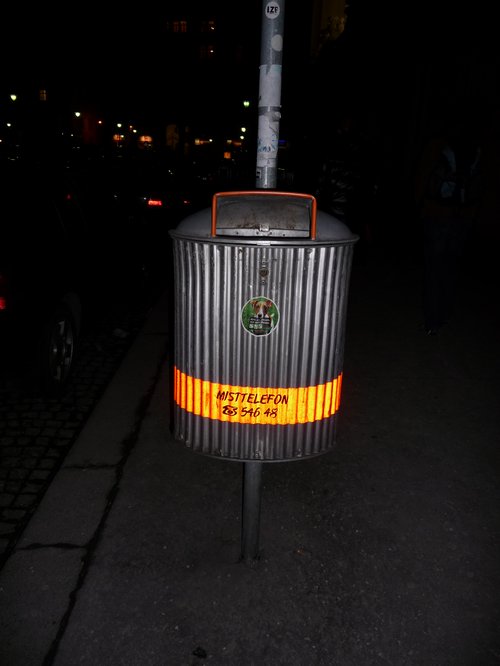
Still need to figure out why they’ve put this number on all waste bins.
Interesting to compare German German with Austrian German.
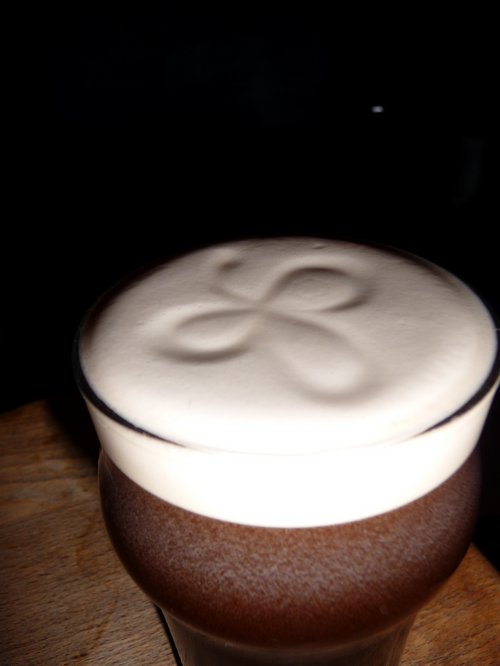
I will actually go for almost any beer, but – just for the records – they also have Guiness.
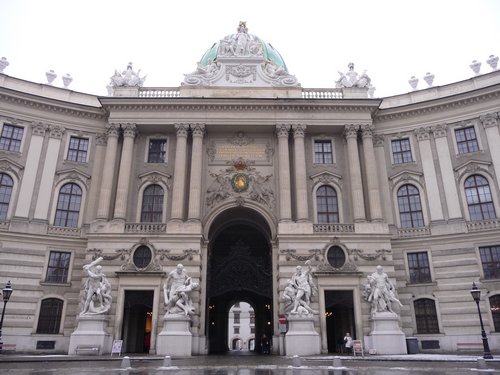
Now this is very impressive. Even have a panorama shot of this somewhere (I still need to go through all of my snapshots and upload them on flickr).
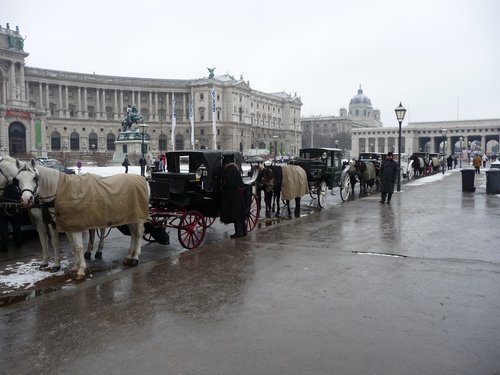
The obligatory service for tourists. But a nice one indeed!
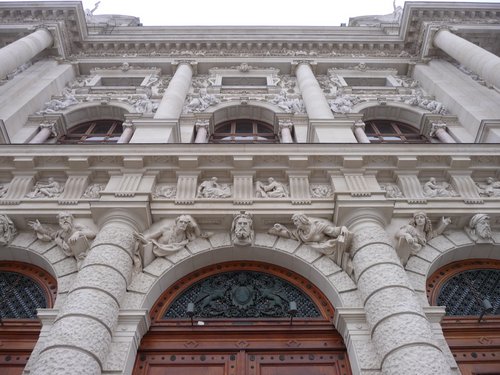
Compared to buildings from the past, modern architecture is as uninteresting as most modern cars that will break down after 100.000 kms.
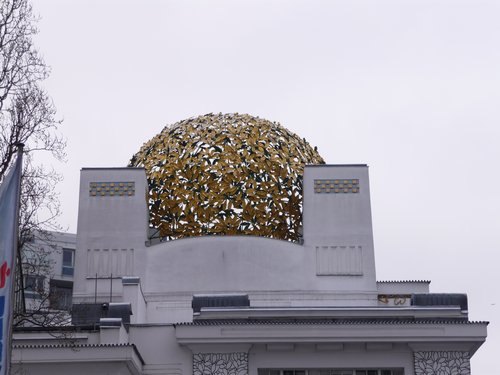
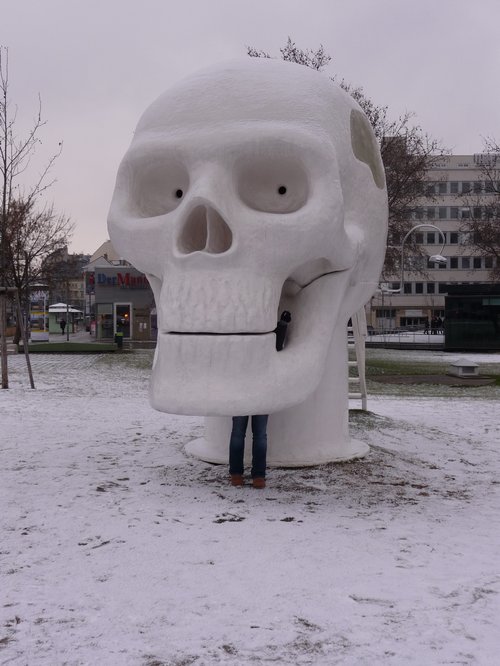
Modern art + her.
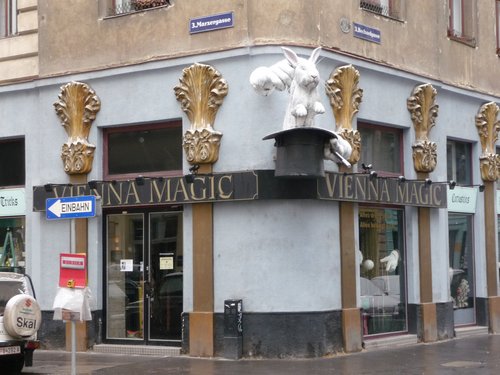
Vienna Magic

The globe
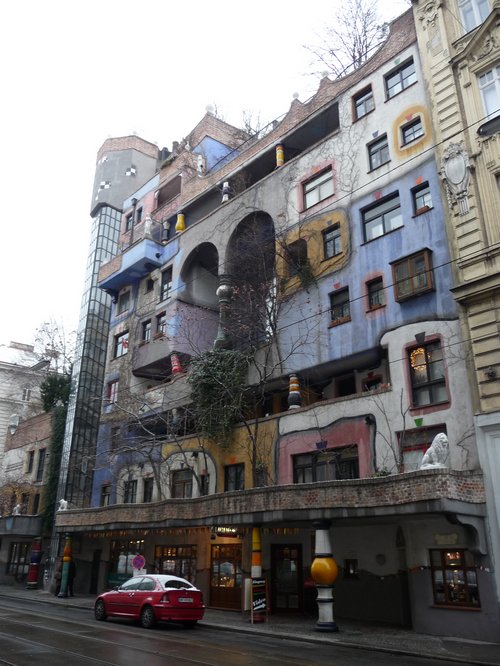
One of those Friedensreich Hundertwasser buildings.
I grew up on his art – maybe everyone in Europe who is somehow interested in art did – and I really, really like it. Hundertwasser also published a manifest on dry toilets in 1975 which is just another cool reason to adore this great visionary artist and intellectual.
You won’t have to visit Vienna to see his work, but since he was born in Vienna, they have the best collection around.
I’d even go as far as saying that Hundertwasser is one of the few visionaries that put my vision of a better world in a clearer picture.
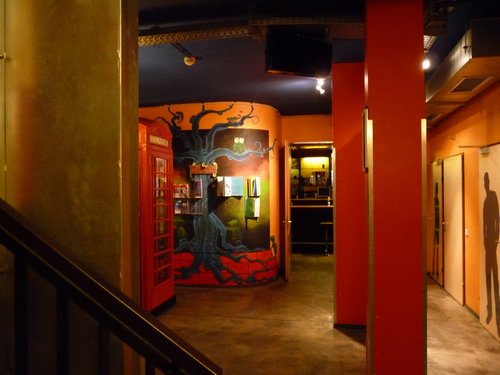
Foyer @ Wombat’s Base – a great, clean and cheap city hostel. I’d recommend this to anyone who’s still looking for good accomodation in Vienna.
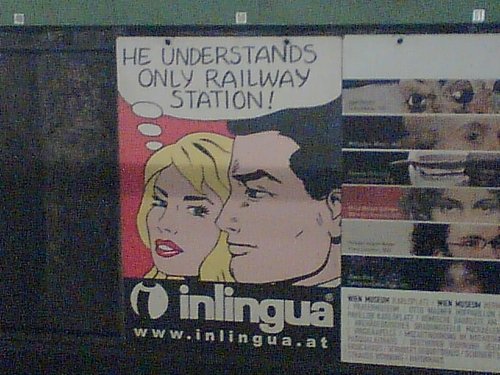
“We’re sinking, we’re sinking….” – “Wot are you thinking about?”
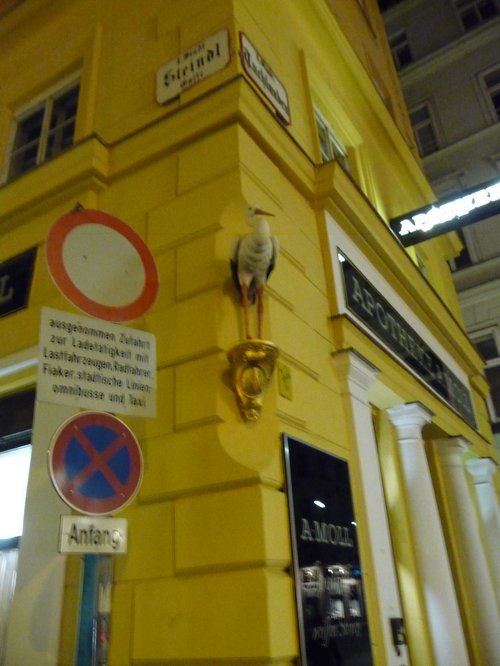
Errr….well….
Ok – that’s about it for today. These 2 1/2 days weren’t enough and you can see by the pictures that we even didn’t have enough time to enjoy everything during daylight (due to AfrikaCamp, see previous post). Train ride from Frankfurt to Vienna is quite convenient though. Took us 7h – even the above mentioned hostel is next to the railway station. What a luxury!
New year’s resolutions are supposed to be made – and then quickly forgotten.
I can’t even remember if it was a new year’s resolution, but it’s January 2009 now and the wife (“she”) said we’d have to go on a diet. South-Beach Diet.
If you’re married or at least engaged, you’ll know that wise men never oppose a female decision (but instead wait for them to remorse on their own). This especially applies to those poor fellows who are married to Thatcheresque characters.
The painful truth is that she’s right. We both urgently need to lose weight – not because we’d been surviving on junk food only (she’s vegetarian anyways), but because food in Germany is just more than nutritious. Whenever I am in Kenya, I lose weight. But here in Germany, it’s just massive. And then all these sweets!
Sweets, dear readers, are one of the two fine reasons why I like German food (the other is Bavarian Leberkäse). And not only packaged Haribo winegums and liquorice, but also fresh cakes from a bakery:

Choice 2.0
Now compare that with the usual “variety” of marble cakes as found in the average Kenyan supermarket. What a difference and sweet temptation!
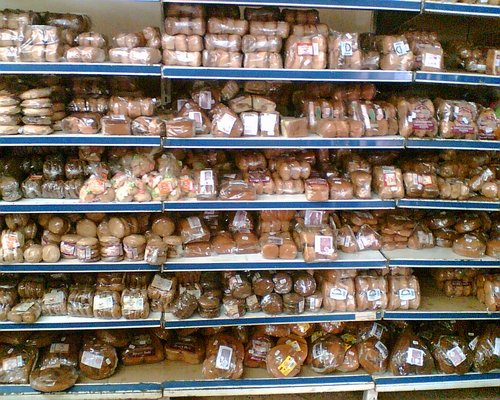
Choice 1.0
Ati? Do I hear you longing for the typical BlueBand (instead of butter) “butter” cream cake?
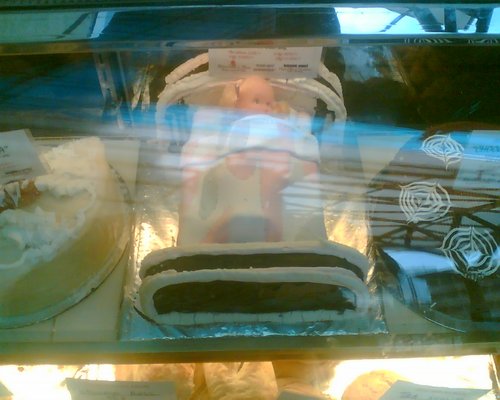
The strange Barbie cake found in Nbo the other day
See? That’s the dilemma now. Living in a country where the sweets section alone can fill up a whole supermarket and even provides a bigger variety than the usual and rather boring marble & butter cream cakes as found in ex British colonies (sorry, but I blame this heritage purely on the British inability & disinterest in cooking & baking), you’ll quickly end up eating too many sweets. Just because they are readymade food and can be eaten quickly. And of course because I love sweets.
Other members of the extended family already tested this diet – or let’s say: change of diet, and it worked quite well for them. You’re basically not allowed to eat any bad carbohydrates during the first two weeks, which obviously also includes sugar, bread, potatoes and so on. The list of the NO-GOs is actually quite long – the one of those things you’re allowed to eat rather short.
As you may know or not know: Germans love to have a sweet breakfast (e.g. bread with jam), so this diet requires her to switch to scrambled eggs and bacon instead (ok, this is what I like about UK kitchen at least).
As for lunch and dinner, we’ve so far prepared vegetable dishes based on chickpeas, eggplant, garlic and sometimes even meat (for me, not for her). The meat part actually is quite nice because I didn’t have a proper steak until Xmas and until my good old ex-vegetarian sister Zora recently informed me she’d switched to being a carnivore. @Zora – in case you’re reading this: see how your actions influence my life! :-)
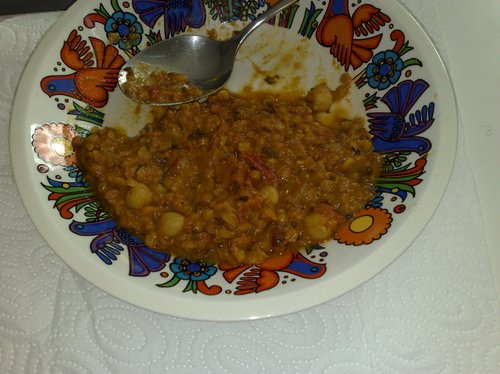
A snapshot I’d already twitpic’d: looks like Githeri to me, bila potatoes and beans. That’s dal fry, actually. Lentils + onions + tomatoes + some chick peas + curry. Delicious!
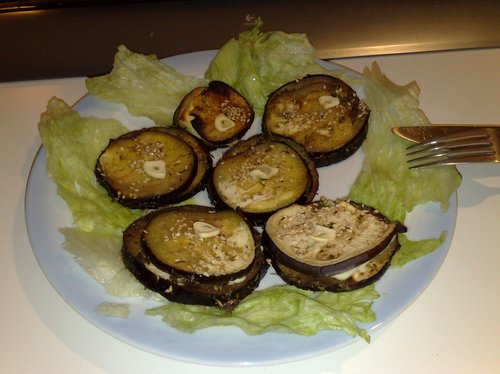
Eggplant/Aubergine with Turkish cheese and garlic + sesame. Grilled in the oven. This really is a perfect dish anyone can prepare within a few minutes.
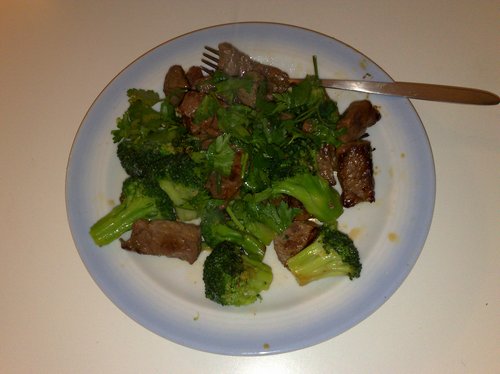
Some kind of steak I’d cut into pieces because I wasn’t sure about its age (@intelligensia see “Rost and mboilo”, p.46 , “How to be a Kenyan”). Next time I will just choma this kabisa in the grill. Love the fresh broccoli though, very al dente (mushy food is a no-go except for Irio). I shall have even more meat during the coming weeks. Yay!
—–
Other, food related matters that are worth mentioning and actually require their own post is Vegefarm – a vegan/vegetarian restaurant opened by very good friends of mine in Bremen – a city in Northern Germany.
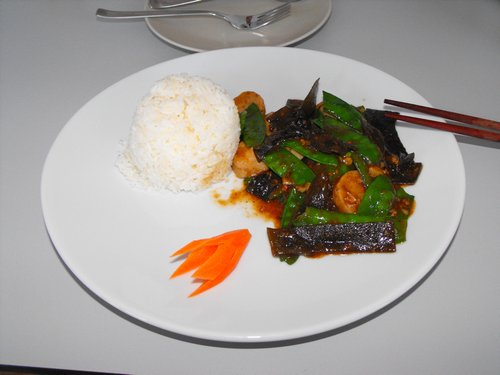
What they do is serving special dishes that almost taste like real meat or fish, but are purely based on gluten, tofu and shitake mushrooms and probably also other vegan ingredients. Quite SE Asian – they used to have a Chinese restaurant (already serving vegan dishes back then) but have since switched to this cuisine only. And best of all is that you can order these fake meat and fish balls based on Tofu & Co. online. I’d seen them importing these directly from Taiwan some years ago, so it’s extremely nice to see them coming up with a full restaurant these days that only serves such dishes.
Those dark green “leaves” on the image above are algae from the sea – and since I grew up on Japanese food, I really, really love the taste of this green seaweed.
—–
Yes – that’s about it so far. From seaweed to ugali na sukuma to sweets. And there you go wondering why I’d gained weight.
Interestingly though, and the intial reason for blogging all of this: it seems that if you want to survive on staple food only (starch), you’ll pay much less. Try to find decent (!) vegetable during winter season in Europe and you’ll quickly realize that the only place where vegetaboools taste like having grown under the sun (and not in some artificial greenhouse in Spain) is among Turkish supermarkets, next to those Afroshops downtown.
Of course, once I’m done and have lost my targeted 10kgs (hey..easy!), I will have to start my Leberkaese business idea in Kenya :-) Serving tasty meat snacks to commuters – how’s that for a change?
p.s.: I consider this post part of my lifelong Bantu-food-bashing-meme which aims at spreading Swahili food culture from the Kenyan coast to all parts of Central Kenya. Eh!